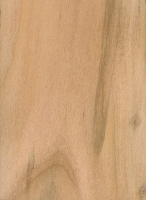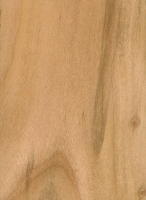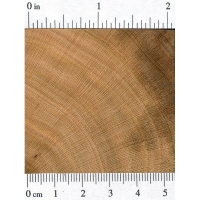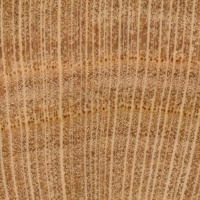 |
Common Name(s): Apricot Scientific Name: Prunus armeniaca Distribution: Native to eastern Europe and Asia; planted worldwide Tree Size: 20-40 ft (6-12 m) tall, 1-1.5 ft (.3-.4 m) trunk diameter Average Dried Weight: 46 lbs/ft3 (745 kg/m3) Specific Gravity (Basic, 12% MC): .58, .74 Janka Hardness: 1,390 lbf (6,200 N)* *Estimated hardness based on specific gravity Modulus of Rupture: No data available Elastic Modulus: No data available Crushing Strength: No data available Shrinkage: No data available |
Color/Appearance: Heartwood is light brown, sometimes with a reddish or orangish cast. Darker brown streaks are common. Sapwood is generally thin, and is slightly paler than heartwood.
Grain/Texture: Fine even texture with moderate natural luster.
Endgrain: Semi-ring-porous; solitary and radial multiples; medium to small pores sometimes arranged in broken earlywood rows, very numerous; mineral/gum deposits occasionally present; parenchyma not visible; medium to large rays, spacing normal.
Rot Resistance: No data available.
Workability: Areas with straight and clear grain are easy to work with hand or machine tools. Care must be taken when surfacing irregular grain or knots to avoid tearout. Apricot glues, turns, and finishes well.
Odor: No characteristic odor.
Allergies/Toxicity: Besides the standard health risks associated with any type of wood dust, no further health reactions have been associated with Apricot. See the articles Wood Allergies and Toxicity and Wood Dust Safety for more information.
Pricing/Availability: Not commercially available in lumber form due to very small tree sizes, Apricot is most commonly seen among hobbyists and other small specialty woodworkers and related retailers. Most commonly sold in turning blanks or other small sections. Prices are likely to be high for a domestic wood.
Sustainability: This wood species is not listed in the CITES Appendices or on the IUCN Red List of Threatened Species.
Common Uses: Turned objects, musical instruments, carvings, and knife handles.
Comments: Although Apricot is related to Cherry (Prunus genus), it tends to be heavier and harder than Cherry, and much more scarce. Sizes are very limited, so Apricot tends to be assigned primarily to smaller, more decorative purposes.
None available.





I recently saw a video of turning logs into lumber and got inspired. Just made a coaster out of a piece small piece of Apricot, I am actually shocked how nice the wood looks and it sands so smoothly. Very keen on making more out of Apricot and maybe even some peach.
Would apricot be good for making a Bo Staff?
Robert your guitar is beautiful! Have you come across any examples of acoustic guitars made from apricot? I have not been able to find any. I too harvested an apricot tree that I planted at 5 from an apricot I ate from another tree in my backyard. 40 years later It needed to come down and thought can an acoustic guitar be made from my tree.
//:0 I made a guitar out of an Apricot tree in my yard that was diseased. Recovered good sections and dried for two years. There were some challenges but I’m very happy with the results.
Would be interested to see some pictures if you’ve got them.
Here are a few shots.
Very nice!
Just realized that I should mention that the guitar neck is not apricot. The fretboard is pau ferro.
I’ve just made a chopsticks from apricot wood. Looks so pretty.
Apricot is divine to turn – finishes glass smooth, turns easy, and color variation draws immediate attention. It does turn black against metal suggesting pretty high tannin content making it a great candidate for ebonizing.
Add or presoak in some blacl tea, and you can ebonize just about anything pitch-black
I had 2 small trees, the i germinated from a tasty apricot, and decided to plant. Never got any fruit, last year I cut one, but since I curve and sculptures in wood, I kept the wood. To my surprise, as I start cutting it to boards I discover how hard and beautiful light color this wood is.
We had a really large apricot tree which was about 18-20″ in diameter. Had to cut it down due to disease and age. I have carved over 80 serving spoons. The wood is beautiful. I have re-saved a bunch of boards and they are drying in the shed. Plan on making cutting boards, boxes and probably more spoons. I cut two large 18″ rounds which are about 2 inch thick that I plan on making three legged stools as well.
My husband made this clock from apricot wood.
Looks nice! What makes that grain “surreal” is the ray flecks, which are usually about the same color as the surrounding wood in most fruitwoods, but on these pieces, it looks like the wood is darker, while the rays are still light brown, giving it a lot of contrast.
I concur that apricot wood is a very beautiful wood and have also made over 70 serving spoons. You are the first person that I have found that also carve spoons using apricot wood. Keep up the beautiful work.